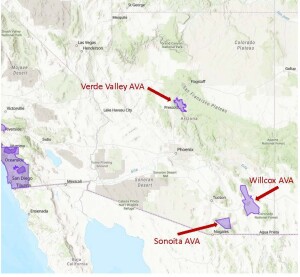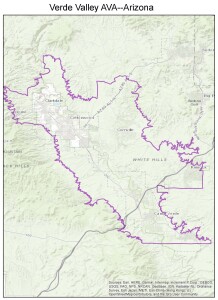On November 10, 2021, the TTB (Alcohol and Tobacco Tax and Trade Bureau) of the United States announced the approval of the Verde Valley AVA. When this new AVA—along with the Lower Long Tom AVA, also announced today—comes into force on December 10, the total number of AVAs in the United States will be 260. Verde Valley represents the third AVA in Arizona, along with the Willcox AVA (approved in 2016) and the Soinita AVA (approved in 1984).
The Verde Valley AVA—centered along the junction of Oak Creek and the Verde River and covering a total area of 219 square miles—is located somewhat in the geographic center of Arizona. The new AVA is entirely within Yavapai County and includes the communities of Cottonwood, Clarkdale, Jerome, Cornville and Camp Verde.
According to the original petition, the distinguishing features of the Verde Valley AVA include its climate, soils, and topography, as discussed below:
Climate: According to the petition, the Verde Valley AVA receives significantly less average rainfall than the surrounding regions (thus necessitating the use of irrigation in nearly all of the commercial vineyards). The area enjoys slightly warmer temperatures and more available sunlight than the surrounding areas—while at the same time, the area boasts a much greater degree of diurnal temperature variation (up to 30 degrees F). This unique combination allows for dynamic photosynthesis and sugar concentration to occur during the day, coupled with a lower loss of acidity due to respiration at night when compared to the areas that surround it.
Soils: As befits a region centered around a river, the Verde Valley AVA is largely composed of alluvial soils. The high bicarbonate levels in the area’s groundwater helps to increase the pH of the soils, which inhibits nutrient uptake in the vines. This vinous stress helps to produce grapes with a good deal of aroma and flavor intensity.
Topography: The area within the Verde Valley AVA consists of gentle slopes and elevations ranging between 3,000 feet and 5,000 feet (920 to 1,525 m). The surrounding regions—including the Mingus Mountains and the Woodchute Mountains—consist mainly of steep-sloped mountains with elevations up to 8,000 feet (2,440 m). Interestingly, the Verde Valley (including the area extending beyond the AVA itself) is often referred to as “Arizona’s other Grand Canyon.”
According to the website of the Verde Valley Wine Consortium, the Verde Valley AVA is home to more than 20 commercial vineyards with just over 125 acres currently planted to wine grapes (with an additional 40 acres planned). The area is home to at least 11 wineries—including Caduceus Cellars, the Original Jerome Winery, Cabal Cellars, and Arizona Stronghold—and 25 tasting rooms.
More than 40 different grape varieties are grown in the Verde Valley AVA. Leading white grapes include Malvasia Bianca, Viognier, Chardonnay, Vermentino, Seyval Blanc, and Picpoul Blanc; leading red grape varieties include Syrah, Petite Sirah, Cabernet Sauvignon, Sangiovese, Tannat, and Barbera.
Welcome to the world, Verde Valley AVA!
References/for more information:
- Verde Valley AVA Petition
- Verde Valley AVA Petition Appendices
- Federal Register Nov 10 2021-Verde Valley AVA
- https://verdevalleywine.org/
Post authored by Jane A. Nickles…your blog administrator: jnickles@societyofwineeducators.org


This area is really unique to Arizona. I’m lucky to work in the industry here at Page Springs Cellars which 2 of our vineyards are situated on Oak Creek. We specialize in Rhone varietals.